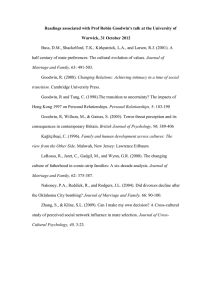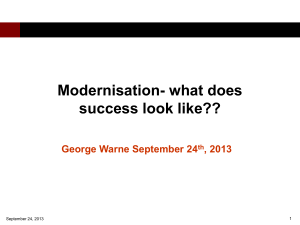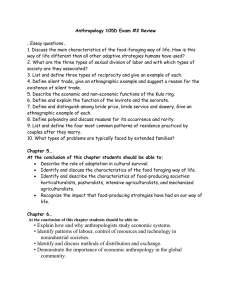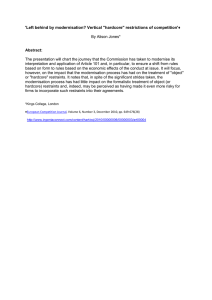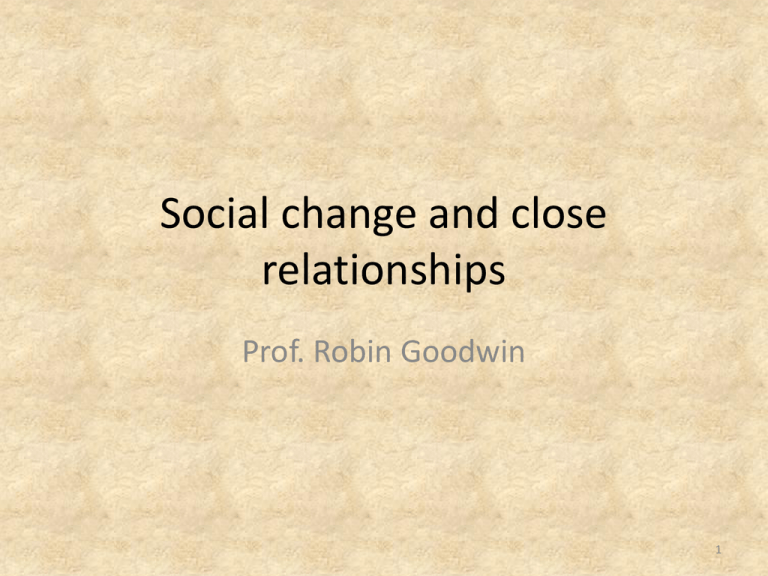
Social change and close
relationships
Prof. Robin Goodwin
1
Social change…A big topic
• A large topic, in the social sciences. Discussed as far
back as the Ancient Greeks.
• Henri Tajfel (1972) "the central issue of social
psychology should be the study of psychological
processes accompanying, determining, and
determined by social change” (p. 4).
• But: little is known about either short or long term
adaptation to social changes (Moghaddam & Crystal,
1997), possibly because such 'real-world' work is
difficult to do in 'controlled' laboratory conditions (de
la Sablonniere et al., 2008, 2009).
2
Social change, culture and
relationships
• Cross-cultural psychologists have written little about
social change (although see Inglehart’s WVS). Often
do not recognise change in their data (e.g. Hofstede)
• Relationships researchers have traditionally rarely
examined social change. However relationship
change part of everyday discourse
– Arranged, even forced marriages
– Low marriage rates / increasing divorce
– Concerns about relationship intimacy
– Many old worries but inform current debates
3
Contemporary relationship issues
4
In this talk, I consider
The impact of ‘gradual’ social change e.g. modernisation
Faster, “sudden, rapid, deep, comprehensive” change
(Sztompka, 2000), “singular events of historical dimension”
(Klein & Pötschke) where there is “sharp discontinuity
between the past and the present” (de la Sablonniere et al,
2009) e.g. revolutions, sudden regime change.
3. Threats to societies which threaten our mortality and can
challenge our assumptive worlds (Janoff-Bulman) e.g.
terrorism, earthquakes, major pandemics
1
2
… and their effects on various types of relationships (partner
choice, families, self-disclosure, sexual relationships, social
networks)
5
For this talk: social change
Made up of many components
– leading to “alterations in social phenomena at
various levels of human life from the individual to
the global” (Lauer, 1977).
– Influenced by many factors, including physical
environment, social structure, personalities, social
organisation (Khaldun, 1332-1406)
– Interactive; e.g. economies change changes in
everyday lives new behaviours, but also
potential resistance etc.
6
Part 1: Gradual change
• Idea of “progress”; reflects 18th century + concerns.
Most see economic conditions driving ideas, others
view ideas as central (‘ideational accounts’) Weber:
development of capitalism followed particular
Protestant ideas.
• Social evolutionary approach. Move from rural and
local life to complex, evolved cities. Parsons: move
from ‘primitive’ to ‘intermediate’ phase and finally
‘modern’ society.
• Not always optimistic: e.g. Tonnies and Durkheim
talk of alienated modern societies
7
Modernisation hypothesis
• Modernisation and industrialisation leads to a range
of predictable social and cultural consequences
(Inglehart & Baker, 2000).
• World values survey: from pre-industrial societies to
‘taming’ of nature in industrialisation.
• Pre-industrial societies: intolerant of abortion, divorce
or homosexuality, emphasise social conformity.
Distrust out-groups, strong emphasis placed on
gender roles, sexual norms.
• Post-industrial societies (less reliant on manufacture).
Self-expression important, challenging traditional
views about relationships. Individuals trust others,
tolerate difference.
8
Some negative consequences of
modernisation
• Since Middle Ages, modernisation associated with
corruption and vice. New values: pleasure seeking,
hedonism and self-centeredness (Yang, 1996).
• Beck & Beck-Gernsheim (2002) demands for
individual freedoms undermine communities.
• Traditional family allegiances and solidarities
fractured (Allan, 2001), personal lives restructured,
social networks re-negotiated. Decline in sincere and
meaningful exchanges, ‘McDonaldized’ world
• Marriage a shell of its former self, family break-ups
threatening extended relations (Almond, 2006)
9
The impact of communication
Tradition --------------------------------------> Modern
All have been seen as undermining the development of true, intimate relationships
10
Example of modernisation: Choosing a
marital partner
• Capitalism loosened traditional bonds through
movement of labour and romanticisation of love
(Giddens). New romantic love sublime and special.
• Evidence in US for decrease in value of chastity and
women as good housekeeper, greater similarity
between sexes in partners desired.
• By 1960s ‘the relationship’ discussed as open, nonviolent and equal. But relationship also fragile and
demanding.
11
Mate preferences in the US over 6
decades
12
Source: Buss et al, 2001; Journal of Marriage and the Family
Greater freedom in dating (China)
• Xu (1997): 3,200 married couples interviewed. 80%
Shanghai couples met at school or work or through
mutual friends, only 37% from underdeveloped rural
province of Gansu met this way.
• 1987 – 1996: dating of classmates and friends /
colleagues more than doubled (from 27% - 56%).
• Traditional Chinese family influences undermined by
– Migration to towns and overseas (250 million)
– Exposure to Western models, new economic ties and
relationships
– One child policy
13
Online relationships
• Facilitate weak ties, make meeting others easier
(Hogan, 2011).
• Internet dating: Previously the “nerds, desperate, and
socially inept” has become socially acceptable way of
meeting partner. Estimates 1:5 meet their partner
online.
• Facilitate relationships amongst sub-communities or
who find difficult to meet others. Help replace ‘work
relationships’ increasingly denied by harassment fears
etc.
• Boase & Wellman (2006): two dominant views on
internet relationships.
– Utopian perspective: internet as a great democratising agent.
– Dystopian: internet eroding family life and ‘real’ relationships
14
Example 2: Family
and marriage
• Modernisation hypothesis: move away from ‘the
traditional family’ to smaller nuclear model (although
large rural extended families often a myth).
• Some evidence of increasingly affectionate
relationship with children
• Individualism increases marital expectations.
Bauman, Bellah et al: destruction of private lives and
community through individualisation. The I rather
than the We that dominates
• But evidence of continuing commitment to marriage
and parenthood.
15
Is Marriage for Lifetime (US
representative samples, agree)
Thornton & Young-Demarco (2001) Journal of Marriage and the Family.
16
Example 3: Sexual relationships
• Relaxation of tight ‘moral values’ in many Western
societies.
• Invention of ‘plastic sexuality’ (Giddens).
‘Commodification’ of relationships (Bauman)
• In UK women born in 1930s 38% virgins at age of
marriage; for those born 30 years later < 1%.
• Decrease in age at first intercourse over last few
decades in most countries.
• However evidence in ‘backlash’ against extra-marital
sex in US and UK. Related to ‘romanticisation’ of
partnership?
17
Attitudes to extramarital sex (always
wrong)
Thornton & Young-Demarco (2001) Journal of Marriage and the Family
(US General Survey Survey).
18
Example 4: Social Networks
• Gradual increase in importance of friendship (Pahl).
Friendship as “social glue in contemporary society”
• Social diversity creates new solidarities, based on
trust but fewer obligations. This particularly for
women as enter education.
• Social capital: “connections among individuals”
Decline hypothesis (Putnam, Fukayama) particularly
due to TV (Putnam).
• However, arguable that the rise of Facebook and
similar sites (e.g. Mixi) can both strengthen and
extend networks, helping develop “weak ties”
(Walther, 2009). Provide opportunity for creating new
desirable identities (Krämer & Winter, 2008
19
)
Like a hug?
20
Issues with simple modernisation
hypotheses..
• Idealised ‘traditional’ joint families in both western
and non-western societies were rare
• Often gender relations persist for centuries, despite
modernisation (e.g. Japan: Moghaddam)
• Industrialisation may reinforce traditional practices
e.g. Kinship networks for new businesses (‘pseudokin’). Economic changes introduce modernising and
traditionalising pressures into a society
• Huntingdon (1996): rejects convergence hypothesis,
‘clashes’ in civilisations. Religion important in
cultural change (see also WVS)
21
Modernisation ≠individualisation
• Kagitcibasi (1996): family independence and
interdependence can go together
• Three models
– Interdependent (traditional collectivist). Material and
emotional dependent. Son preference, and high fertility
– Independent (the ‘individualistic’). Separateness,
autonomy, low fertility
– Emotional/psychological interdependency. Social
structural/economic change plus cultural continuity.
Emotional dependencies do not decrease; children are
companions.
22
Example: European families
• Georgas et al (1997) family structures in Greece and
Cyprus, Netherlands, UK and Germany.
• Cypriots and Greeks had greater intimacy and more
contact with family members
• However, this only true for relations with extended
(not nuclear) families
• Suggests nuclear family still important for most
cultures.
23
Part 1: In Summary
• Modernisation, globalisation and the like are
frequently discussed in the media and politics
• Despite assumptions that these inevitably undermine
relationships, many of these gradual changes adaptive
and functional (e.g. use of internet for those living
busy, mobile lives).
• Further, attitudes towards commitment often more
‘traditional’ than assumed.
24
Part 2: More dramatic changes
• Sudden regime change, substantive new policy
directions (e.g. Cultural Revolution) challenge large
numbers and encourage new ways of relating. May
leave less time for ‘gradual adaptations’.
• Changes evaluated differently by different people.
• Individual differences (e.g. personality, beliefs/
values, coping strategies, employment experiences),
group factors (e.g. social class, ethnic group, sexes,
location, education, group norms) and cultural history
(cultural “baselines” or cultural zones)
25
Example 1: Choosing a marital partner
• Expediency: In China
– 1950s: cadres of CCP most popular
– 1960s: technicians and workers
– 1970s: military officers permitted migration
– 1980s: de-collectivisation meant bride price and
dowry (again) significant
• Religion: Tashakkori & Thompson (1988, 1991).
Impact of Iranian Islamic revolution: return to
influence of parental involvement in partner choice
• Scarcity: Impact of civil war in Lebanon on marriage
rates. ‘Marriage squeeze’ effects (lack of men). ’More
26
beautiful than a monkey’ (Russian saying).
Example 2: Social Networks and Trust
• Strong social networks needed to survive in
Communist system, but also issue of suspicion/ trust.
Establishment of ‘official social networks’ (e.g.
Czech Association of Catholic Clergy)
• Following end of Communism, levels of trust in
Eastern Europe actually fell. New competitiveness for
jobs, less security
• Rainer & Siedler (2006): German reunification
(1994-2002 data). Institutional distrust fell, but social
distrust high. Moderated by employment experience.
27
Trust in East Europe 1990, 1999
40
30
20
10
Trust 1990
0
Trust 1999
Bulgaria
Estonia
Czech
Lithuania
Poland
Russia
Romania
Slovakia
Country
Adapted from World Values Survey data, www.worldvaluessurvey.com
28
Trust in East/ West Germany
Source: Rainer & Siedler (2006) ISER working paper 2006-31
29
Example 3: Self-disclosure
• Self-disclosure ‘that which individuals reveal about
themselves to others’ (Derlega, et al, 1993)
• We (Goodwin et al, 1999) compared disclosure
during Glasnost in Russia, Hungary and Georgian
Republic (N = 450), contrasting entrepreneurs,
manual workers and students in each country
• Disclosure moderated by a) target of disclosure and
b) topic discussed c) culture and d) age. Disclosure
mediated by fatalistic world-views. Hungarians
disclosed most, Russians least. Students disclosed
more, as did those with lower psychological fatalism.30
Example 4: Sexual relationships
• Where there are too many: One child policy (China,
1979) associated with decrease in number of children.
Evidence of ‘little Emperors’ as result.
• Where there are too few: Singapore. Encouragement
of large families following labour shortage of 1980s.
In Caucescu’s Romania abortion was abolished in
state hospitals.
• Situations of civil conflict: forced migration often
leads to workers living in limited space, sharing
rooms with families/ strangers.
31
Example 5: Marital relations
• Transition of Hong Kong to mainland seen as stressful by
many; around half considered leaving before 1997
transition.
• We (Goodwin & Tang, 1998) randomly dialled > 400 HK
married individuals in HK shortly before the handover,
interviewed in Cantonese.
• Questions included appraisal of threat by couple, couple
disagreements as a result of the transition and negative
impact of transition on relationship
• Found individuals’ sense of control and perceived group
anxieties correlated with worries about the handover. These
worries predicted negative changes in the marital
relationships
32
Example 6: Parenting values
• Post-communist Europe: we (Goodwin &
Emelyanova, 1995) asked 600 Russian students,
business people and manual workers about how
good father/ mother should act towards child, and
qualities to develop in a child
• Most saw main duties of parent to be kind and
attentive. However, students and entrepreneurs
stressed parents tutorial role and more individualistic
qualities
• ‘Collective good’ emphasised by manual workers;
emphasises group differences.
33
Example 7: Gender equality
• In theory, complete equality in Communist Europe.
• Post-Communism, unemployment used as an excuse
for greater stereotyping. Woman to return to ‘her
womanly mission’ (Gorbachev, 1987). Reduced childcare facilities but considerable pressure for all to
work, often in multiple jobs
• Media images rejected grim heroic determinism of
Communist woman, replacing her with a glamorous
woman reflecting position of her husband or father
• May be situation, culture specific: amongst Iranian
migrants to Sweden women have enhanced power
34
and resources (Darvishpour, 2002)
Part 2: In Summary
• Less predictable, faster moving events (e.g. the end of
Communism) may provide less opportunity for
relationship adaptations
• During times of transition people may be suspicious
of others, disclosing carefully to only certain
individuals.
• Different appraisals of changes, by different groups
of people, may lead to varied relationship outcomes
• Some relationships may become ‘more traditional’
(e.g. when economic threats women ‘returning’ to
the home) or ‘less traditional’ (e.g. when children
gain greater power).
35
Part 3: Traumatic events
Christchurch, 2011
36
Trauma and relationships
• We often cling to others when threatened, and are
more likely to contact and maintain close
relationships in times of anxiety (e.g. the
alleviation of anxiety, Schachter, 1955; Mikulincer
et al., 2003).
• Some traumatic events can question assumptions
about a benevolent world (Janoff-Bulman, 1992),
although positive informal social interactions can
help restore these e.g. following terrorist attacks
(Vazquez & Paez, 2010).
37
Example 1: Terrorism research
• We (Goodwin et al, 2005) conducted face-to-face
questionnaire data collected on central London streets
following the July 2005 bombings (9th-14th July) and
at the same time each month (August, September and
October 2005)(N=429)
• Examined various predictors of anxiety (values,
family/friend’s perceptions of risk of attack, control
over being a victim), perceived risk of future attacks
or concern about being a victim
• Outcomes included contacts with friends and family
38
Terrorism study findings
• Demographic variables, shared normative perceptions
and values predicted fear of a future event…
• This fear predicted an increased closeness with
significant others.
• Benevolence also increased for a while – but just a
while…
39
Benevolence values, 2003 then after
7/7
4.9
Mean benevolence = 12 + 18
4.8
4.7
4.6
4.5
4.4
4.3
Sept 03
August 2005
July 2005
waves with Michelle's data
October 2005
September 2005
However, relating to strangers..
• With non intimates, anxiety can also lead to poorer
relationships, particularly with out-group members
• Those on ‘fringes’ of society particularly seen as
importers of disease (Douglas, 1992). Because
infection is often hidden, this allows a ready
opportunity for accusation or exclusion (Douglas,
1992).
• On SARS: “The social representation of SARS
resonates with representations of infectious diseases
throughout history: we lay the blame for the new
threat on those outside one’s own community, the
‘other’” (Washer, 2004)
41
Terror Management and Evolutionary
approaches
• Terror Management Theory: When we fear for our
life (“mortality salience”) we may reject out-group
members, feeling comfortable only with those who fit
our stereotypes, rather than challenge them (Schimel
et al, 1999).
• Evolutionary theory (Schaller): functionally evolved
processes lead us to avoid those immunologically
dissimilar individuals. Intergroup contact increases
the risk of diseases.
42
Example 2: Swine Flu
• We (Goodwin et al, 2009) collected data from 480
respondents in Malaysia and Europe in the three
weeks following the announcement of the swine
flu epidemic/ pandemic Stage 5 by the WHO (29th
April 2009).
• Those most likely to be ‘outgrouped’ (homeless,
homosexuals and prostitutes) seen as at
significantly greater risk of swine flu, particularly
in Malaysia
• Respondents who were most anxious were
quickest to see these outgroups as at risk
(supporting TMT).
43
Swine Flu (2)
• In a follow up study of 120 Malaysian pig
farmers in 2009 (Goodwin et al, 2011), 64%
claimed their social life is worse as a result of
SF, and 35% that friends, 41% family, did not
want to spend time with them since the
outbreak.
44
Tsunami in Japan (2011)
Taro area in Miyako city
Yamada Village
45
Example 3: Earthquakes and radiation
• Following such events, people may cling to their
partners for security.
• 2011 Axa Insurance data from Kanto following the
Great East Japan earthquake (N=10,000). > 85%
married people said opinion of partners improved;
while 46% single people in a previous survey said
would not rush into marriage, this fell to 41% after
the quake and nuclear disasters
• With non intimates, anxiety can lead to rejection:
hibakusha – those in the nuclear affected areas,
shunned by others and refused shelter access
(Goodwin et al, 2012).
46
Relationship growth?
Or stereotype amplification?
48
Taken together: a ‘relationship
amplification’ hypothesis
• Following dramatic events, some close relationships
may get closer, or at least more committed. Shortterm benevolence and support
• However, ‘outsiders’ may be rejected, even more than
before
• The wider social network might be enhanced (as
people mobilize new allegiances) – but also
exhausted (the ‘deterioration’ hypothesis) (Kaniasty).
49
Should all relationship changes be
equal?
• Are there some aspects of our relationships that might
change more than others?
• How do these relate to our individual personality,
setting, culture?
50
Core relationship characteristics
• Probably meet evolutionary demands. Less likely to
fluctuate with short term political and economic changes
in a society. Tran-situational, weakly correlated with
individual/ cultural values
• Example 1: Intense affectional bonds neuorchemically
mediated from mammalian heritage (Diamond, 2003).
Important for initial mating rituals, help offspring develop
in context.
• Example 2: Desire for a healthy partner
• Example 3: Strongly emotional love styles such (e.g. eros
and mania; Neto et al, 2000) and relationship ideals.
51
Moderated beliefs/ cognitions
• Moderated by personality and other individual
differences, in a similar manner in each culture and
during different times.
• May arise from differential upbringings (in particular,
attachment experiences) with universal impact on
internalised working models of relationships.
• Example: Fatalism mediates the influence of social
support on well-being in a similar manner across
cultures (Goodwin et al, 2001).
52
More variable relationship behaviours
and cognitions
• May correlate with relevant culture-level values and
beliefs / axioms. Less consistent across situations.
• Example 1: Many actual (rather than ideal) behaviours in
a relationship
• Example 2: ‘Realistic’ partner preferences, and love styles
such as ‘pragma’ (Lee, 1973). Might reflect male: female
population ratios as well as age, marital status etc.
• Example 3: Emotions influenced local expectations and
networks, e.g. loneliness (Suh et al, 1998; Goodwin et al,
2002).
53
Concluding comments (1)
• Few simple messages, despite ‘catchphrase
sociology’ that talks largely about ‘declines’ (social
capital, sexual morals, family values). Simple
modernisation must be questioned: who is
modernising? Where? (at home, at work?) Why?
• Dramatic changes in a culture can impact on
relationships, often in unexpected ways (e.g. when a
Church group backs homosexuality for political ends)
54
Concluding comments (2)
• Major threatening events may amplify underlying
relationship dynamics. These must be considered over
time; short term relationship gains may not always
last (e.g. with new social networks)
• Not everyone is effected equally by social changes:
different groups and cultures must always be
considered. These provide “pools" of resources and
coping styles, which may moderate behaviours .
• Some characteristics more changeable than others:
often evolutionary-rooted behaviours/ ideals more
universal than actual behaviours
55
Thank you!
Please ask me for readings etc.
56

